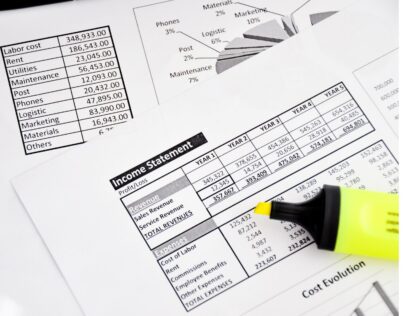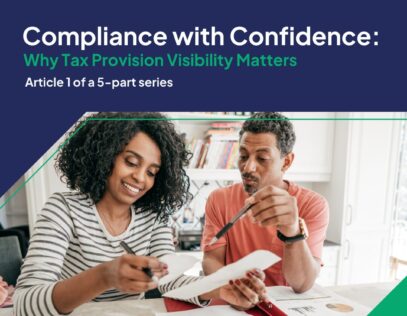If you’re an accountant at a publicly listed company, not many things are likely to keep you up at night more than the thought of having to restate your financials.
Your CFO will be stressed (his job may even be on the line), the CEO will be fielding calls from panicked investors, and the SEC will be wondering if it needs to investigate.
Re-statements are mercifully rare, but they do happen. And even the most diligent accounting department can get tripped up by ever-changing accounting rules and the ever-growing volume of company data.
A likely stumbling block? Taxes. Problems arising from the calculation of the tax provision are one of the most common sources of accounting error cited by auditors.
The challenges inherent in the tax provision process are well known: The computation should be completed with care—the result must be accurate enough to pass inspection by auditors.
It must be completed quickly—the result will be expected just days after quarter-end. And it should be completed timely, accurately, and thoughtfully—the result should both offer insight into a company’s past performance and help shape the plan for the future.
But why does this process even exist? And what makes it so difficult to get right? Non-tax professionals might think you just multiply your company’s pre-tax earnings by the statutory tax rate and take the rest of the day off. Unfortunately, (or, if you’re an accountant who enjoys being employed, fortunately), things are not that simple.
Calculating a company’s tax provision is a complex task—primarily because the worlds of tax and accounting play by different rules. While a company’s pre-tax book income is computed based on accounting principles, its tax provision is calculated based on tax law.
To prepare a complete and accurate tax provision, tax accountants must bridge the gap between these two sets of rules. And to build this bridge, they need a firm grasp of both tax law and accounting standards—and how exactly these diverge.
Further complicating things, tax accountants must stay abreast of the latest developments in both accounting and tax. If not, inaccuracies in the provision are likely to ensue, potentially leading to the dreaded re-statement of financials—with all the attendant consequences from both management and auditor.
“To prepare a complete and accurate tax provision, tax accountants must bridge the gap between two sets of rules.”
The Exactera Takeaway:
- While a company’s pre-tax book income is based on accounting rules, the tax provision is based on tax rules
- Tax accountants must bridge the gap between the two sets of rules by having a must firm grasp of both tax law and accounting standards—and how these diverge
- Accountants working on tax provisions must stay abreast of the latest developments in the ever-changing worlds of both accounting and tax
Playing by the Rules
In general, accounting rules are accrual-based—meaning that expenses are recorded to the income statement when incurred and revenues are recorded when earned.
In contrast, tax rules are generally cash-based, calling for expenses to be deducted when cash is spent and revenue to be included as income when cash is collected. But, because tax law is never straightforward, there are a slew of exceptions.
A variety of rules call for following either an accrual accounting or hybrid approach (i.e. somewhere in between the accrual and cash principles). To understand why these rules differ so much, it helps to consider what the regulators are looking to achieve.
Accounting rules are geared towards slowing down income and speeding up expenses, making financial statements more conservative. Accounting regulators hope thereby to prevent companies from misleading investors and creditors with inflated earnings reports.
“Accounting rules are geared towards slowing down income and speeding up expenses, while tax rules aim to do the opposite.”
Meanwhile, tax rules aim to do the opposite. Here, the rules are designed to speed up income and slow down expenses, resulting in higher earnings and lower costs. The regulator’s intention in this case is to prevent companies from delaying tax payments by deflating income or inflating expenses on their tax returns (and thus lowering taxable income).
Bridge Building
The starting point of the tax provision calculation is a company’s accounting data, summarized into a trial balance.
The trial balance is a detailed listing of accounts that includes everything found on a balance sheet—assets, liabilities, shareholder equity, as well as the income and expense from the income statement. This represents a company’s complete financial activity for the past reporting period.
At the end of the fiscal year, when the books are closed and preliminary trial balances are available, complete and accurate provision data is not yet available. This puts the tax department in a difficult position.
They must rely upon the data they have from the preceding year or make their best guess—assumptions based upon the data they have. Starting with pre-tax book income, tax adjustments for both permanent and temporary differences are calculated to determine federal taxable income.
The key to converting book-to-tax income is identifying the items that are subject to change and calculating the corresponding tax adjustment. As this is done quarterly and annually, companies already know what items need to be adjusted from book to tax amounts. The challenge is getting timely and accurate data for the calculations.
This is the bridge between the two sets of rules, accounting and tax, so let’s take a look at an example.
In 2010, a large-cap energy conglomerate had a massive oil spill. Aside from the environmental and societal costs involved, there were also tremendous penalties incurred by the company. Of these, a portion was paid to the U.S. government for violation of the Clean Water Act. The penalty was no slap on the wrist—it amounted to a whopping $5.5 billion.
In order to prevent an inflated earnings report, it’s clear how this penalty was to be treated for accounting purposes. It’s simply an expense that was recorded at the time it was incurred (i.e. when it was assessed).
However, this expense is treated quite differently from a tax perspective.
The government legislates to influence taxpayer behavior. In this case, tax law disallowed the deductibility of the expense entirely because the U.S. government prohibits the deduction of fines and penalties incurred from the violation of the law. The government is extending the fine in an economic sense by disallowing the expense as a business deduction.
As the penalty stemmed from a violation of the Clean Water Act, it was not tax-deductible. This resulted in a disparity between the accounting and tax treatment of the penalty, leading the oil titan to have an M-1 adjustment for the entire $5.5 billion expense.
Permanent vs. Temporary
There are two types of M-1 adjustments: Permanent differences are expenses for accounting purposes that are never deductible for tax purposes. Meanwhile, temporary differences are expenses for accounting purposes that are not currently deductible for tax purposes but will be in the future.
“There are two types of M-1 adjustments: permanent differences and temporary differences.”
The oil titan example illustrates a permanent difference: The penalty is an expense for accounting purposes that will never be deductible for tax purposes because it’s disallowed under tax law. Conversely, accrued bonuses represent a temporary difference.
For accounting purposes, this item is accrued as an expense as the bonuses are earned by employees. For tax purposes, the bonuses are not deductible until actually paid out (subject to a notable exception, which is beyond the scope of this article). So, in contrast to the penalty example, both sets of rules, accounting and tax, allow the expense to be deducted. But the timing differs—hence, it’s a temporary difference.
Once again, this differing treatment achieves the respective goals of each set of standards—accounting rules speed up the recognition of expenses while tax rules slow it down. As intended, investors receive a conservative assessment of the company’s performance and the government collects its fair share of tax.
The Exactera Takeaway:
- In general, accounting rules are accrual-based, while tax rules are cash-based
- Accounting rules aim to slow down income and speed up expenses, while tax rules aim to do the opposite—speed up income and slow down expenses
- A book-to-tax reconciliation (or M-1 adjustment) compares the accounting treatment of an income or expense item based on the accounting rules to the tax treatment of such an item based on tax rules
- If accounting and tax treatment is the same, there is no book-tax difference. If not, an M-1 adjustment will be made equal to the difference between the amount on the trial balance for an income or expense item and its applicable amount for tax purposes
- There are two types of M-1 adjustments: permanent differences and temporary differences
Did You Know?
- Surveys show that as much as 85 percent of U.S. companies use Microsoft Excel to calculate the tax provision
- The provision for income tax has a life of its own and is subject to constant change, which creates challenges in the static environment of Excel
- AI-driven tax provision software identifies new trial balance account numbers and saves time that is better allocated to more value-added activities
- Exactera Tax provision software also provides analytic tools empowering tax professionals to take the provision beyond just number crunching to more value-added tax planning activities.







